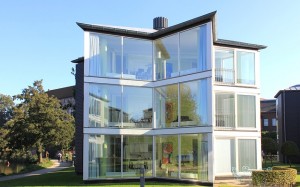
There’s more to window technology than putting together sheets of glass. Some claim you can feel 10°C cooler inside with more efficient windows…how do they do it?
I moved in to a great new apartment with big windows and bright rooms. Unfortunately, summer and west-facing makes a dreading hot room in the evening.
That’s why some big bold letters “feel 10°C cooler” caught my eye. It was advertising a new window product that effectively turns a normal window into a double-paned (or double-glazed) window. Another exaggerated ad, I thought. Sunlight through a window is like pouring boiling water into a ceramic mug – it might not burn immediately, but the heat still seeps through and I wouldn’t want to touch it.

However, reading further I found that a high-tech energy efficient window was not only a simple sandwich of glass + air + glass. You can make this setup a slightly more efficient thermal insulator with some crafty materials science:
- Choose your layers: double or triple-paned? Even quadruple and quintuple layered glass have been created for use in extremely cold regions. The air between the glass layers slows the heat transfer from one side of the window to the other, helping (I emphasize “help”) temperature control. Therefore, the more layers, the better the insulation, but the windows will be bulkier and heavier.

Layers of glass at a metro entrance. Photo by Ganymedes Costagravas. - Choose your filling: Replace the air between the glass layers with argon, krypton, or xenon gas. These gases cut heat flow to half or even fractions less of that in air, although xenon is not a realistic material to use based on availability and cost. You can also remove air altogether and turn it into a vacuum (a no-air or extremely low-pressure condition).

Gases such as argon (Ar), krypton (Kr), and xenon (Xe) are part of the group of noble gases and have great thermal insulation properties. The gases are odorless and non-toxic. Image from wikipedia. - Choose your finishing coat: On the surface of the windows, adding an extremely thin and transparent layer of metal (e.g. silver) blocks out UV rays. This way, you can cut out most of the heat without creating a sunglass-like tint on the window that darkens the room. The type of metal(s) used and the method of coating the glass affects how effective the window is against heat.
Furthermore, glass-making companies have experimented with varying thicknesses of glass, thicknesses of the air space, and the material used for the window frame and spacers (the material holding the two layers of glass together and sealing the air space).
Each choice has its pros and cons, and the suitability of each depends on your location and building based on factors like climate, building codes, and frame of the building (consult a home specialist if you’re considering to get one, this article explores some of the options only). The intriguing part is that a variety of choices in building a window can make noticeable changes in insulation efficiency, some examples in this chart.

Eventually, with super materials around like ultra thin glass or ultra insulating foam like aerogel (explained beautifully in Mark Miodownik’s book Stuff Matters), there might be further exciting advances in window technology!
